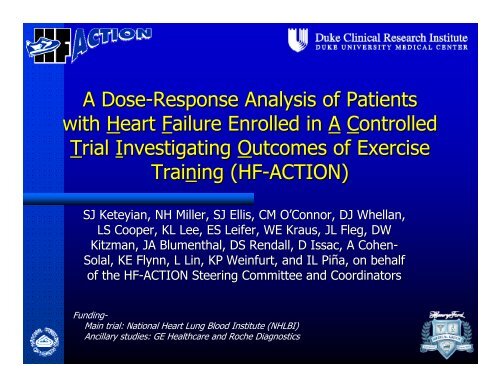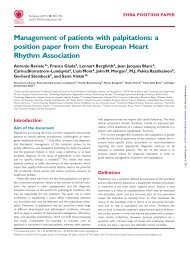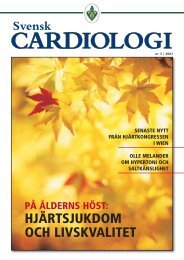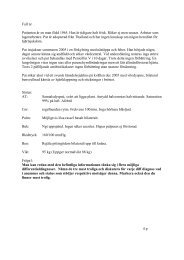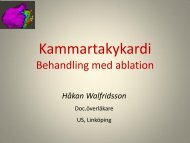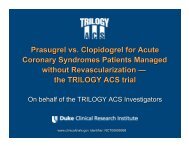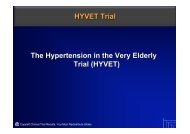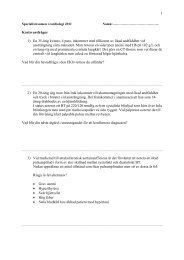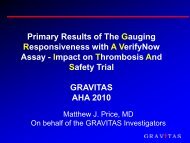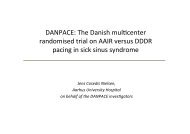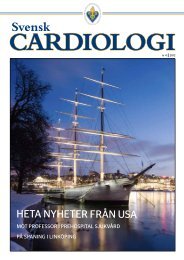HF ACTION slides
HF ACTION slides
HF ACTION slides
You also want an ePaper? Increase the reach of your titles
YUMPU automatically turns print PDFs into web optimized ePapers that Google loves.
Presenter Disclosure InformationA Dose-Response Analysis of Patients with HeartFailure Enrolled in A Controlled Trial InvestigatingOutcomes of Exercise Training (<strong>HF</strong>-<strong>ACTION</strong>)Presenter: Steven J. KeteyianFinancial Disclosures: NoneUnlabeled/Unapproved Use Disclosures: None
Study Design:<strong>HF</strong>-<strong>ACTION</strong> TrialLVEF !35%; NYHA class II-IV;optimal <strong>HF</strong> therapy ("6 wk);no or irregular exercise (
Background: <strong>HF</strong>-<strong>ACTION</strong> Primary Endpoint(All-Cause Mortality or All-Cause Hospitalization)Event Rate0.80.70.60.50.40.30.2Usual Care0.1Exercise00 0.5 1 1.5 2 2.5 3Years from Randomization(Primary) HR 0.93 (95% CI: 0.84, 1.02), p = 0.13*Adjusted HR 0.89 (95% CI: 0.81, 0.99), p = 0.03*Adjusted for key prognostic factors at baseline: etiology + atrial fibrillation, exercise duration, Beck depression score, ejectionfraction.
Background: <strong>HF</strong>-<strong>ACTION</strong>Secondary Endpoints0.8CV Mortality or CV Hospitalization0.8CV Mortality or <strong>HF</strong> Hospitalization0.70.70.60.6Event Rate0.50.40.30.20.10Usual CareExercise0 1 2 3Years from RandomizationEvent Rate0.50.40.30.20.10Usual CareExercise0 1 2 3Years from RandomizationHR 0.92 (95% CI: 0.83, 1.03), p = 0.14* Adjusted HR 0.91 (95% CI: 0.82, 1.01), p = 0.09HR 0.87 (95% CI: 0.75, 1.00), p = 0.06* Adjusted HR 0.85 (95% CI: 0.74, 0.99), p = 0.03*Adjusted for key prognostic factors at baseline: etiology + atrial fibrillation, exercise duration, Beck depression score, ejectionfraction.
Background: Adherence toPrescribed Exercise in <strong>HF</strong>-<strong>ACTION</strong>% Subjects Adhering toExercise Duration Goal100806040200[ Goal: > 90 min/wk ] [--------------- Goal: > 120 min/wk ---------------]50% Adherence1-3 10-12 22-24 25-36Follow-up Interval (months)Full AdherencePartial Adherence
Hypothesis …! … an increase in the volume of exercisecompleted per week would beassociated with a reduction in clinicalevents, as well as an improvement inexercise capacity and health status.
Study Outcomes! Clinical Events– All-cause death or all-cause hospitalization– Cardiovascular death or cardiovascular hospitalization– Cardiovascular death or heart failure hospitalization! Exercise Capacity– Peak VO 2 (mL#kg- 1 #min- 1 )– Six-minute walk distance (m)! Self-Reported Health Status– Kansas City Cardiomyopathy Questionnaire (KCCQ)! Scale: 0-100; 0higher score = better health status
Quantifying Exercise DoseVolume: MET-hours per week• Hours per week $ average exercise intensity duringtraining (METs)Example: (typical study subject)2.0 hr/wkX 2.0 MET activity (e.g., walk @ 1.4 mph)4.0 MET-hr/wk2008 DHHS, Physical Activity Guidelines Advisory Report: Target for Healthy Adults = ~ 8 MET-hr/wk[e.g., brisk (3 mph) walk for 30 minutes, five days per week]
Statistical Methods! Methods for determining covariates: pre-defined list of 32variables; reduced using backward elimination.! Assess the relationship between the volume of exercise perweek and the occurrence of clinical events after 90 days.– “Landmark-type Analysis”! Statistical analysis– Clinical events: Cox proportional hazards model– Exercise capacity: Multivariable linear regression (complete caseanalysis)– Health status: Longitudinal linear mixed model
Study Design:Dose ResponseGroupLVEF !35%; NYHA class II-IV;optimal <strong>HF</strong> therapy ("6 wk);no or irregular exercise (
Results: Baseline Characteristics ofDose Response Group (n = 959)Age (yr) *Female (%)African American (%)NYHA Class II / III / IV (%)LVEF (%) *Ischemic Etiology (%)Diabetes (%)Atrial Fibrillation/Flutter (%)History of Stroke (%)Body Mass Index (kg#m -2 )*Peak VO 2(mL#kg -1 #min -1 ) *Beck Depression Inventory II ScoreCPX Duration (min) ** Median (25th, 75th)59 (51, 67)313265 / 34 / 125 (20, 30)5032211030 (26, 35)14.7 (11.6, 17.8)8 (5, 15)10 (7, 12)
Baseline Characteristics, Volume of Exercise, and Risk for All-CauseDeath or All-Cause Hospitalization After 90 DaysCovariateHR (CI)p-valuePeak VO 2 (mL#kg -1 #min -1 )0.95 (0.93-0.97) 19.2
Volume of Exercise and Risk forClinical Events after 90 DaysCV Death orCV HospitalizationCV Death or<strong>HF</strong> HospitalizationRisk Reduction Per 1 MET-hr/wkAll-Cause Death orAll-Cause HospitalizationHR (CI) *0.95(0.92-0.98)0.95(0.92-0.99)0.89(0.84-0.94)* Adjusted Cox proportional hazards model% 28.86.816.7p-value0.0030.009
Volume of Exercise and Improvement in ExerciseCapacity and Health Status at 90 DaysPeak VO 2 (mL . kgkg -1.KCCQ score (points)*Slope estimate (SE)1.min - 1 )Six-min walk distance (m)Increase at 90 days per1 MET-hr/wk of exercise*0.18 (0.028)4.23 (0.76)0.73 (0.12)p–value
Possible Clinical Implications forTypical Patients from <strong>HF</strong>-<strong>ACTION</strong>Two Typical Subjects:Each 59 yr, ischemic CMY,NYHA class II,LVEF = 25%,VO 2peak= 14 mL#kg -1 #min -1One walks 2 mph, 30 min,3 d/wk = 4 MET-hr/wkClinical risk: & ~ 18% (6% – 28%)! Peak VO 2: + 0.7 mL#kg -1 #min -1! KCCQ: + 2.9 pointsAnother walks 2.5 mph, 25 min,5 d/wk = 6 MET-hr/wkClinical risk: & ~ 26% (9% – 39%)! Peak VO 2: + 1.1 mL#kg -1 #min -1! KCCQ: + 4.4 points
Study Limitations! Patients were not randomized to differentdoses of exercise– Confounding due to unobserved factors– Results must be interpreted with caution! Some covariates (e.g., BNP, creatinine) whichinfluence clinical outcomes were not availableon all subjects and therefore were notincluded in the analysis.
Conclusion: In patients with chronic heart failure,a 1 MET-hr increase in the volume of exerciseperformed per week is associated with …! ~ 5% lower estimated risk for all-cause deathor all-cause hospitalization! ~ 0.2 mL#kg-1 #min-1 higher peak VO 2 at 90 days! ~ 0.7 point higher KCCQ score at 90 days
ConclusionThis analysis:! Quantifies the dose response relationship betweenregular aerobic exercise and patient outcomes amongsubjects in <strong>HF</strong>-<strong>ACTION</strong>.! Provides insight as to how volume of exercise mayhave contributed to the modest improvement inclinical, fitness and health status outcomes observedin the main <strong>HF</strong>-<strong>ACTION</strong> Trial.! Provides additional information regarding the use ofregular aerobic exercise in the management ofpatients with heart failure due to left ventricularsystolic dysfunction.


